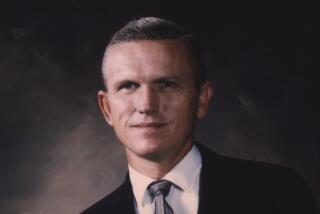Pioneer Flier Is a Giant--at Least in Wenatchee : Aviation: He and his co-pilot made the first nonstop flight across the Pacific 60 years ago. He landed in the small Washington city, which considers him a genuine hero.
- Share via
WENATCHEE, Wash. — He is not among the Wrights, the Lindberghs, the Earharts or even the Corrigans, the pilots who are universally remembered as the pioneers of aviation.
But at least in Wenatchee, Wash., Clyde Pangborn is a giant.
Sixty years ago, on Oct. 5, 1931, Pangborn and co-pilot Hugh Herndon Jr. landed their small plane in this central Washington city after making the first nonstop flight across the Pacific Ocean.
Thus, the local airport is named Pangborn Field. The North Central Washington Museum has a major Pangborn exhibit that includes the plane’s bent propeller. There is a stone marker on the spot where the plane, the Miss Veedol, touched ground. And Wenatchee’s sister city is Misawa, Japan, near the start of Pangborn’s flight.
“It’s still the biggest news ever to happen in Wenatchee,” said Carl Cleveland, who covered the event as a young newspaper reporter.
Pangborn was born in Bridgeport, Wash., and grew up in St. Maries, Ida. An engineer, he began flying for the U.S. Army Signal Corps during World War I.
After the war, he became a barnstormer with Gates Flying Circus. He met Herndon, scion of a wealthy family, in 1929 and they barnstormed together.
In 1931, they tried to break the around-the-world record of eight days and 15 hours set a few months earlier by Wiley Post.
The trip was beset with problems from the start, and the aviators decided to abandon the quest when their plane was damaged during a landing in Siberia. While in Siberia, they learned of a $25,000 prize offered by a Japanese newspaper for the first nonstop flight from Japan to the United States. They took off for Japan, which at that time was at war in Manchuria, and flew over the Japanese island of Hokkaido.
Their load included a 16-millimeter movie camera, which drew the attention of Japanese authorities when they landed at a Tokyo airport.
They were charged with espionage, found guilty and ordered to pay fines of $1,050 each. Supporters in the United States wired money to pay the fines so they could make their historic flight.
They rigged their plane’s 300-pound wheels with steel pins and cables so they could drop them once in the air--reducing the plane’s weight so its fuel would carry it farther. They had to do this secretly; the Japanese government had put harsh restrictions on such flights after several aviators lost their lives in failed attempts.
The Miss Veedol, loaded with 915 gallons of fuel and 45 gallons of oil, was too heavy to take off at the short runway in Tokyo. They moved to Sabishiro Beach, about 300 miles from the city.
To further reduce weight, they carried no radio, life raft or parachutes.
They took off on the afternoon of Oct. 3, and 300 miles out, they dumped the wheels. Later, Pangborn had to crawl out of the plane and onto an icy wing at 17,000 feet to unscrew landing gear rods so they could make a belly landing.
Once they reached the Puget Sound area, Pangborn decided to seek another $25,000 prize offered for the first one-stop flight from Japan to Dallas.
He knew they would need a long runway to take off with a refueled plane, and headed for Spokane, where Pangborn knew there was enough room. The airport there was fogbound, so they turned back west to Wenatchee, where Pangborn’s mother and brother lived.
Cleveland, a friend of Pangborn, remembers there were about a dozen people and only two reporters at the Wenatchee airport--no one was sure Pangborn would come there.
“At 7 a.m., they came over the hills,” said Cleveland, who was on the phone to his editor at the Wenatchee newspaper describing the scene. That editor in turn was on the phone to the Associated Press in Seattle, relaying the story to the rest of the world.
“He made a circle at first and dumped the last of his gas,” Cleveland said. “They went south toward the Rock Island Dam and came in low. Pangborn was fishtailing to slow down the plane as much as he could.”
With Herndon sitting in the tail to add weight, Pangborn brought the red Bellanca down on the dirt runway and skidded along the ground. The plane went up on its nose, bending the propeller, but then settled back on its belly.
The two pilots climbed out of the plane. Herndon had suffered a cut on his head from a flying can of motor oil.
The 4,558-mile flight had taken 41 hours and 13 minutes. A representative for the Asahi newspaper was on hand to provide the $25,000 check. The Dallas businessman, however, was not so generous, saying the two pilots would not qualify for his prize.
Herndon later became a TWA executive and died of a heart attack in 1952.
During World War II, Pangborn made 170 flights across the Atlantic, flying bombers and transports to England. After the war, he became a test pilot. He died in 1958.
And the Miss Veedol, Cleveland said, was put on display for tourists for a time in Seattle. It was then sold to a dentist; he perished in the Atlantic Ocean while trying to fly the plane to Italy.
More to Read
Sign up for The Wild
We’ll help you find the best places to hike, bike and run, as well as the perfect silent spots for meditation and yoga.
You may occasionally receive promotional content from the Los Angeles Times.






